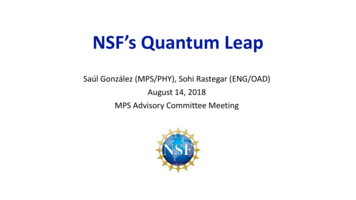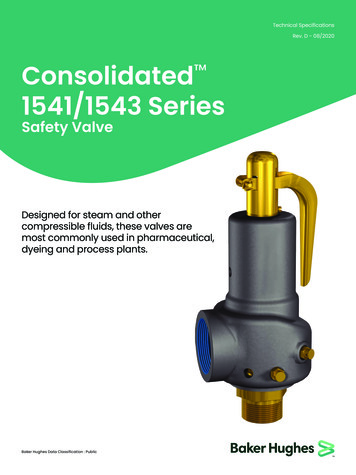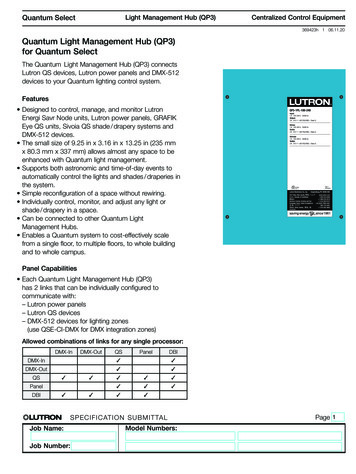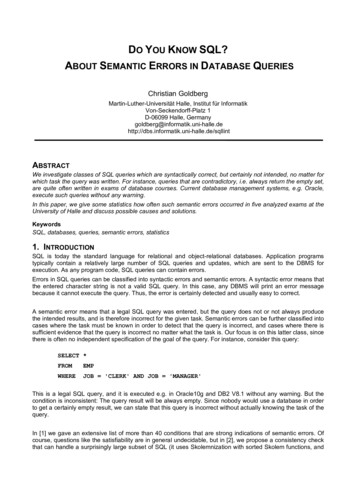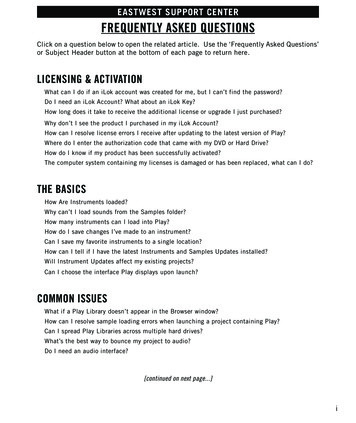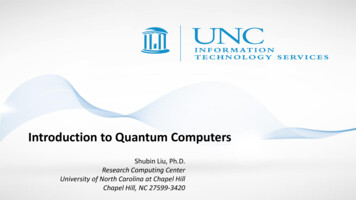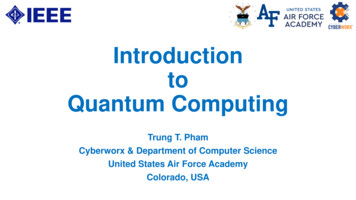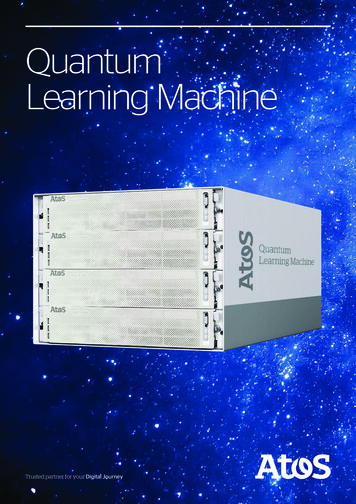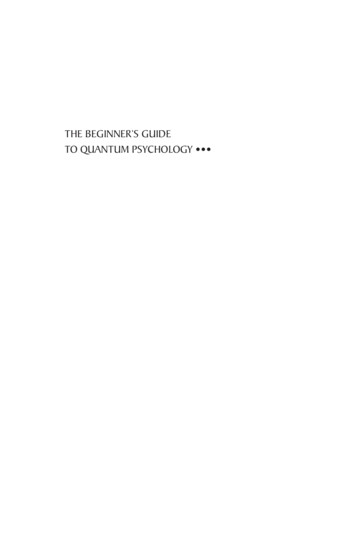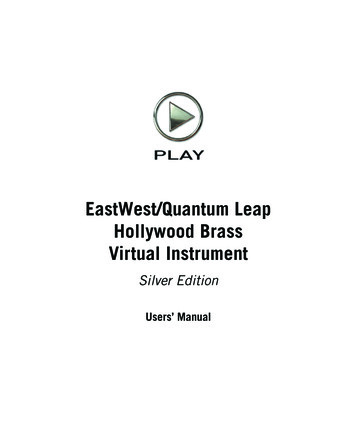
Transcription
EastWest/Quantum LeapHollywood BrassVirtual InstrumentSilver EditionUsers’ Manual
EASTWEST/QUANTUM LEAP HOLLYWOOD BRASSThe information in this document is subject to change without notice and does not represent a commitment on the part of East West Sounds, Inc. The software and soundsdescribed in this document are subject to License Agreements and may not be copied toother media , except for the purpose of copying the data to the personal computer systemhard drive of the licensed user. No part of this publication may be copied, reproduced orotherwise transmitted or recorded, for any purpose, without prior written permission byEast West Sounds, Inc. All product and company names are or trademarks of theirrespective owners.PLAY is a trademark of East West Sounds, Inc. East West Sounds, Inc., 2010–2012. All rights reserved.East West Sounds, Inc.6000 Sunset Blvd.Hollywood, CA 90028USA1-323-957-6969 voice1-323-957-6966 faxFor questions about licensing of products: licensing@eastwestsounds.comFor more general information about products: .comVersion of July 2012ii
EASTWEST/QUANTUM LEAP HOLLYWOOD BRASS1. Welcome2345678889About EastWestProducer: Doug RogersProducer: Nick PhoenixProducer: Thomas BergersenSound Engineer: Shawn MurphyCreditsHow to Use This and the Other ManualsUsing the Adobe Acrobat FeaturesThe Master Navigation DocumentOnline Documentation and Other ResourcesClick on this text to open theMaster Navigation Document1
EASTWEST/QUANTUM LEAP HOLLYWOOD BRASSWelcomeAbout EastWestEastWest (www.soundsonline.com) has been dedicated to perpetual innovation and uncompromising quality, setting the industry standard as the most critically acclaimedproducer of Sample CDs and Virtual (software) Instruments.Founder and producer Doug Rogers has over 30 years experience in the audio industryand is the recipient of over 60 industry awards, more than any other sound developer.His uncompromising approach to quality, and innovative ideas have enabled EastWest tolead the sound-ware business for more than 22 years.In 1997 Rogers partnered with producer/composer Nick Phoenix and set up QuantumLeap, a wholly owned division of EastWest, to produce high-quality, no-compromise sample libraries and virtual instruments. Quantum Leap virtual instruments are mostly produced by Nick Phoenix. Some of the larger productions, such as Symphonic Orchestra,Symphonic Choirs, Quantum Leap Pianos, and Hollywood Strings are co-produced byDoug Rogers and Nick Phoenix. As a composer, Phoenix began scoring film trailers andtelevision commercials in 1994. To date, he has either scored or licensed music for thead campaigns of over 1000 major motion pictures including Tomb Raider 2, Terminator3, Lord of the Rings Return of the King, Harry Potter 2, Star Wars Episode 2, Spiderman3, Pirates of the Caribbean 3, Blood Diamond, Night at the Museum, and The Da VinciCode. Quantum Leap has now firmly established itself as one of the world’s top producers of high-end sample libraries and virtual instruments.In 2006, EastWest purchased the legendary Cello Studios (formerly United Western Recorders) on Sunset Boulevard in Hollywood, re-naming it EastWest Studios. The 21,000sq. ft. facility, since remodelled by master designer Philippe Starck, houses five recording studios and is the world headquarters for EastWest.Chapter 1: Welcome2
EASTWEST/QUANTUM LEAP HOLLYWOOD BRASSProducer: Doug RogersWith over 30 years experience in the audio industry, founder and producer Doug Rogersis the recipient of over 60 industry awards, more than any other sound developer. Hisuncompromising approach to quality, and innovative ideas have enabled EastWest tolead the sound-ware business for more than 22 years. “The Art of Digital Music” namedhim one of “56 Visionary Artists & Insiders” in the book of the same name.He released the very first commercial Drum Samples CD in 1988, and followed it withthe multiple award-winning “Bob Clearmountain Drums” sample collection which he coproduced. In the years that followed he practically reinvented the sound-ware industry.EastWest introduced loop sample libraries to the market in the early nineties, followedclosely by the first midi driven loops collection (Dance/Industrial). He released the firstlibrary to include multiple dynamics, followed by the first sample library to stream fromhard disk, an innovation that led to the detailed collections users expect today.His recent productions are Symphonic Orchestra (awarded a Keyboard Magazine “Key BuyAward,” EQ Magazine “Exceptional Quality Award,” Computer Music Magazine “Performance Award,” and G.A.N.G. [Game Audio Network Guild] “Best Sound Library Award”);and Symphonic Choirs (awarded Electronic Musician “2006 Editor’s Choice Award,”G.A.N.G. “Best Sound Library Award,” and Keyboard Magazine “Key Buy Award”). Mostrecently, his productions include Quantum Leap Pianos, the most detailed virtual pianocollection ever produced; and Fab Four, inspired by the sounds of the Beatles, a M.I.P.AWinner and judged the most innovative instrument by 100 music magazines.Over the last decade he has partnered with producer/composer Nick Phoenix and set upthe Quantum Leap imprint, a subsidiary of EastWest, to produce high-quality, no-compromise virtual instruments. EastWest/Quantum Leap virtual instruments are consideredthe best available and are in daily use by the who’s who of the industry.Chapter 1: Welcome3
EASTWEST/QUANTUM LEAP HOLLYWOOD BRASSProducer: Nick PhoenixNick began scoring film trailers in 1994. To date, he has scored or licensed music forthe ad campaigns of over 1000 major motion pictures. “Star Trek,” “Tron,” “Percy Jackson,” “Twilight,” “2012,” “WALL-E,” “Indiana Jones 4,” “Harry Potter 6,” “Inkheart,”“Tales Of Despereaux,” “300,” “A Christmas Carol,” “Watchmen,” “Angels and Demons,”“Night at the Museum,” and “Young Victoria” are a few recent examples. Nick founded“Two Steps From Hell” with Thomas Bergersen in 2006. www.twostepsfromhell.comThe journey as a composer has inspired Nick to record and program his own soundsand samples. Nick founded Quantum Leap Productions in 1997 and Quantum leap hassince grown to be the world’s top producer of high-end virtual instruments. A 13-yearpartnership with Doug Rogers and EastWest has yielded award winning software titlessuch as Stormdrum 1 and 2, Symphonic Orchestra, Symphonic Choirs, Silk, RA, VoicesOf Passion, Ministry Of Rock, Gypsy, Quantum Leap Pianos, Goliath, Hollywood Strings,and many others.Chapter 1: Welcome4
EASTWEST/QUANTUM LEAP HOLLYWOOD BRASSProducer: Thomas BergersenThomas Bergersen holds a composition and orchestration Master’s degree, and hasworked in the capacity of composer, orchestrator, or music arranger on many Hollywoodproductions.He founded Two Steps From Hell (www.twostepsfromhell.com) with Nick Phoenix in 2006and has since written music for countless movie trailers. “Star Trek,” “Harry Potter 6,”“Tales of Despereaux,” “The Dark Knight,” “Valkyrie,” “The Hulk,” “Rendition,” “SpiderMan 3,” “Golden Compass.” “The Assassination of Jesse James,” “Pirates of the Caribbean 3,” “Babel,” “Hitman,” “I Am Legend,” “300,” “No Country For Old Men,” “HarryPotter 5,” “The Brave One,” “Wall-E,” “Blood Diamond,” “Speed Racer,” and “Night atthe Museum” are a few recent examples.Thomas is also a trumpetist and has performed on major TV productions including NBCNews. In his pursuit of the ultimate realism in samples, he has produced a great numberof orchestral sample libraries for his own use. With the Hollywood Strings library, andnow Hollywood Brass, it was time to join forces with veteran producers Doug Rogers andNick Phoenix, and to share this knowledge with the rest of the world.Thomas’ studio is located in Santa Monica, California. www.thomasbergersen.comChapter 1: Welcome5
EASTWEST/QUANTUM LEAP HOLLYWOOD BRASSSound Engineer: Shawn MurphyShawn Murphy is an Academy Award, C.A.S. (Cinema Audio Society), BAFTA, and Emmyaward-winning sound engineer who has recorded and mixed the scores for more than300 feature films including: “Indiana Jones and the Kingdom of the Crystal Skull,” “StarWars: The Phantom Menace,” “Star Wars: Episode II - Attack of the Clones,” “Star Wars:Episode III - Revenge of the Sith,” “Star Wars: A Musical Journey,” “Jurassic Park,”“Jurassic Park, The Lost World,” “Harry Potter and the Prisoner of Azkaban,” “Titanic,”“The Curious Case of Benjamin Button,” “The Bourne Ultimatum,” “Minority Report,”“Saving Private Ryan,” “Munich,” “The Passion of the Christ” (score mix), “X-Men: TheLast Stand,” “Memoirs of a Geisha,” “Ice Age 2,” and “Ice Age 3.”Hollywood Strings was the first virtual instrument collection he engineered. And his workwith EastWest/Quantum Leap continued with Hollywood Brass.Chapter 1: Welcome6
EASTWEST/QUANTUM LEAP HOLLYWOOD BRASSCreditsProducersDoug Rogers, Nick Phoenix, Thomas BergersenSound EngineerShawn MurphyProduction CoordinatorRhys MoodyProgrammingJustin Harris, Nick Phoenix, Thomas BergersenScriptingPatrick Stinson, Thomas Bergersen, Klaus VoltmerEditingArne Schulze, Pierre Martin, Justin Harris, Michael DiMattia,Jay Coffman, Spencer Putnam, Andrzej WarzochaArt DirectionSteven Gilmore, Thomas Merkle, Doug Rogers, Nick Phoenix, Thomas BergersenSoftwareDoug Rogers, Nick Phoenix, Rhys Moody, Klaus Voltmer, Klaus Lebkücher,Julian Ringel, Patrick Stinson, Adam Higerd, Ezra Buchla,Truc Phan, Nick Cardinal, Jonathan KranzManualJohn PhilpitChapter 1: Welcome7
EASTWEST/QUANTUM LEAP HOLLYWOOD BRASSHow to Use This and the Other ManualsAll documentation for the EastWest PLAY Advanced Sample System and its libraries isprovided as a collection of Adobe Acrobat files, also called PDFs. They can be viewed onthe computer screen or printed to paper.Each time you install one of the PLAY System libraries, two manuals are copied to thefile system on your computer: The manual that describes the whole PLAY System. This, the largest of the manuals,addresses how to install and use all aspects of the software that are common to alllibraries. The library-specific manual, such as the one you are currently reading. This smallerdocument describes aspects that differ from one library to the next, such as the listof included instruments and articulations.Using the Adobe Acrobat FeaturesBy opening the Bookmarks pane along the left edge of the Adobe Acrobat Reader, theuser can jump directly to a topic from the section names. Note that some older versionsof Acrobat Reader might not support all these features. The latest Acrobat Reader canbe downloaded and installed at no cost from the Adobe web site. (As an example of ahyperlink, you can click on the last words of the previous sentence (“Adobe web site”)to be taken directly to the Adobe site.)When reading this and other manuals on the computer screen, you can zoom in to seemore detail in the images or zoom out to see more of the page at once. If an includedpicture of the user interface, or a diagram, seems fuzzy or illegible, then zoom in usingone of several means provided in the Acrobat Reader software. Note that images areclearest and screen shots most legible at 200% and next best at 100%.The Master Navigation DocumentBecause the EastWest PLAY System is a collection of components, each with its ownUser’s Manual, a Master Navigation Document (MND) is provided to allow users to jumpquickly between these PDFs when being read on the computer screen. This MND is aone-page file with hyperlinks to the PLAY System documentation and to all the librarymanuals. Hyperlinks to this Master Navigation Document are found on the title page ofeach chapter in each document. From there, you can open any other document in thecollection.For example, if you’re reading something in this documentation for the EastWest/Quantum Leap Hollywood Brass (Silver Edition) library, and need to open the manual for thePLAY System as well, go to any chapter title page and click on the link that says, “Clickon this text to open the Master Navigation Document.” It will open in a new window onthe screen. In that document, click on the icon for the PLAY System and its manualwill open in the same window, hiding the MND. You now have both the Hollywood Brasslibrary manual and the PLAY System manual open in separate windows so you can referto them both.Chapter 1: Welcome8
EASTWEST/QUANTUM LEAP HOLLYWOOD BRASSSeparate Diamond, Gold, and Silver ManualsThe EastWest/Quantum Leap Hollywood Brass virtual instrument is available in threeversions: Diamond, Gold, and Silver. And each has a manual slightly different fromthe other, so it is important that you use the correct version of the manual. This is themanual for the Silver Edition. If you have the incorrect version of the manual, contactTechnical Support at EastWest.Important Note for Users of the Silver EditionMuch of the description of this virtual instrument refers to the full products available asthe Gold and Diamond Editions. The Silver Edition is designed as a smaller library forthose who want or require a product that uses fewer computer resources. To that end, itcontains a small subset of the most useful articulations from the larger editions. Somereferences to the size of the library are included here to give readers a sense of the scopeof the full Gold or Diamond Edition.Online Documentation and Other ResourcesFor the most up to date information, visit the support pages at EastWest’s web site.There you can find: information made available after these manuals were written FAQ pages that may already list answers to questions you have suggestions from EastWest and other users of the EastWest PLAY System news about upcoming releasesThe address is:http://support.soundsonline.comYou can also visit the EastWest online forums. There you can read comments and questions from others who use EastWest products and post your own. The many forum participants are a good source of helpful information about both the technical and musicalaspects of this software.The address of the forums is:http://www.soundsonline-forums.comIf you visit the forums to receive support from EastWest (instead of going directly to thesupport site listed above), make sure you post your support request in the Support forumand not in the General Discussion forum.Chapter 1: Welcome9
EASTWEST/QUANTUM LEAP HOLLYWOOD BRASS2. Hollywood Brass, An Overview111314The Design Point for the Hollywood Brass LibraryWhat’s IncludedHardware RequirementsClick on this text to open theMaster Navigation Document10
EASTWEST/QUANTUM LEAP HOLLYWOOD BRASSHollywood Brass, An OverviewThe Design Point For the Hollywood Brass LibraryFollowing in the tradition of the companion Hollywood Strings library, Hollywood Brasswas designed to be the most detailed collection of brass orchestral instruments ever assembled. And with their long history of creating virtual instruments, writing and scoringthe music for hundreds of actual Hollywood trailers and films, co-producers Doug Rogers,Nick Phoenix and Thomas Bergersen already understood what was needed to create theauthentic Hollywood sound.Another factor in defining the sound of this library is that it was recorded in EastWestStudio 1, formerly Western Recorders and then Cello Studios. The recordings createdin this building have, for decades, received more engineering awards than those in anyother studio.Producers Doug Rogers, Nick Phoenix, and Thomas Bergensen,with (2nd from left) Sound Engineer Shawn MurphyThe combination of the right producers, an actual Hollywood recording studio, the bestmics and other recording hardware available, and brass players familiar with the Hollywood sound all came together to capture the authentic sound you can hear in this virtualinstrument.Chapter 2: Hollywood Brass, An Overview11
EASTWEST/QUANTUM LEAP HOLLYWOOD BRASSWhen designing the Hollywood Strings and Hollywood Brass libraries, the producersdecided to take advantage of the recent advances in computer technology that make possible instruments of greater complexity to achieve more realistic results than libraries ofeven two years ago. For example, for over 20 years libraries have been recording multipledynamics for each articulation and layering them to capture the different timbres heardat different dynamic levels. These libraries usually used the MIDI Velocity parameter toselect which layer to play back. While this approach achieved excellent results, it meantthat typically 2 to 5 distinct layers were available, and timbre could not change mid-note.Those libraries would use cross-fades for a small number of patches where mid-notechanges were beneficial. But they kept the number of those cross-fades small to preventtheir greater use of the computer’s memory from becoming overwhelming. In HollywoodStrings and Hollywood Brass, the producers greatly expanded the use of cross-fades,both in their numbers and in how many concurrent voices participate in the cross-fadeswithin a given patch. This approach results in instruments that capture the way brassinstruments can vary the sound during a crescendo or swell, like a live musician playingan acoustic instrument.Studio 1 at EastWest Studios, during setup for the Hollywood Strings recording sessionsThe EastWest sample player software, known as PLAY, had to undergo a few improvements in versions 2.0 and then 3.0 to make these larger instruments possible, especiallyto improve the efficiency of the software when loading and playing back large numbersof samples in a single instrument.When all these factors come together, they create a virtual instrument of unparalleled detail and power. With almost 360 instruments and over 370,000 sample files, the librarycaptures the great variety of sounds possible in a full brass orchestra. (These numbersChapter 2: Hollywood Brass, An Overview12
EASTWEST/QUANTUM LEAP HOLLYWOOD BRASSrefer to the Diamond Edition; the Gold Edition numbers are smaller, and the Silver Edition smaller still.) The PLAY Sample engine lets you create performances that will exciteyour creativity.Comparison of the Diamond, Gold, and Silver EditionsThe Gold Edition is mostly a subset of the Diamond Edition. It is intended for those withsmaller or less capable computer systems, and for those looking for most of the featuresand power of the Diamond Edition but at a smaller price. Here are the differences: Bit Depth: the samples in the Diamond Edition are 24-bit; those in the Gold Editionare 16-bit. Delivery: the Diamond Edition is provided on a hard drive; the Gold Edition is providedon a set of DVDs; the Silver Edition is available to download online. Mic Positions: The Diamond Edition includes samples from 5 independent mic positions that can be mixed together to achieve control over both acoustic vantage andspaciousness of the sound; the Gold Edition provides a single mic position.The list of articulations for the two libraries are the same, except as described above.The Silver Edition has all the attributes of the Gold Edition above, but it has a muchsmaller set of articulations.Those with a Silver Edition license can upgrade to the Gold or Diamond Edition license(and receive the extra content) by contacting EastWest. Details about upgrading are alsoavailable on the SoundsOnline.com website.What’s IncludedThis EastWest/Quantum Leap Hollywood Brass library (Silver Edition) you purchasedincludes all the following: a complete set of sample-based instruments, enumerated later in this manual approximately 9 Gigabytes of 16-bit, 44.1 kHz samples the EastWest PLAY Advanced Sample Engine the unique authorization code that identifies the license you bought manuals in Adobe Acrobat (.PDF) format for both the EastWest PLAY System and theEastWest/Quantum Leap Hollywood Brass Virtual Instrument an installation program to set up the library, software, and documentation on yourcomputer an Authorization Wizard for registering your license in an online databaseOne required item not usually included is an iLok security key. If you already have onefrom an earlier purchase of software, you can use it. Otherwise, you need to acquire one.They are available from many retailers that sell EastWest and Quantum Leap products, oryou can buy one online at www.soundsonline.com.Chapter 2: Hollywood Brass, An Overview13
EASTWEST/QUANTUM LEAP HOLLYWOOD BRASSHardware RequirementsSee the PLAY System manual for a complete list of the Hardware and Software Requirements for installing and running any PLAY System library.The Gold and Silver Editions include the following suggestion:“Because both the size and complexity of many of the Hollywood Brass instruments aregreater than in other PLAY libraries, you will likely need an even more capable systemthan is recommended for those other libraries: Intel or AMD quad-core processor, or higher, running at a minimum of 2.66 GHz 8 GB of RAM or more a 64-bit operating system; and a 64-bit host when running PLAY as a plug-inNote that this is a recommended system, and is more powerful than the minimum ofwhat is required.”If you’re thinking of upgrading at some point to one of the larger editions, you’ll need tokeep that recommendation in mind. But when using the Silver Edition you can probablyfollow the recommendations for a minimal system provided in the main PLAY Systemmanual.Requirements for Sample StorageThe required space on the hard drive for an installation of EastWest/Quantum Leap Hollywood Brass (Silver Edition) is approximately 9 GB (Gigabytes).Chapter 2: Hollywood Brass, An Overview14
EASTWEST/QUANTUM LEAP HOLLYWOOD BRASS3. The Hollywood Brass User Interface1718191920202022PerformanceRound Robin Reset ButtonStereo Double ControlsThe Master Button and Pre-Delay Knob in the Reverb ControlsThe Graphical Representation of the EnvelopeThe Browser ViewPerformance ScriptsThe Articulations Control and KeyswitchesClick on this text to open theMaster Navigation Document15
EASTWEST/QUANTUM LEAP HOLLYWOOD BRASSThe Hollywood Brass User InterfaceEach PLAY library presents its own interface when one of its instruments is the currentone, as specified in the Instruments drop-down in the upper right corner. The image atthe bottom of the page provides an overview of the entire window in Player View whenthe current instrument is from the Hollywood Brass library.Much of this interface is shared by all PLAY System libraries, and the common featuresare described in the PLAY System manual. The Hollywood Brass-specific controls described later in this section are those listed on the next page. If you don’t see a controldescribed in this chapter, look at the PLAY System manual; that’s the other manualinstalled on your hard drive during program setup.Chapter 3: The Hollywood Brass User Interface16
EASTWEST/QUANTUM LEAP HOLLYWOOD BRASSHere are the controls described in this manual (and not in the PLAY System manual): Performance Round Robin Reset Stereo Double the graphical representation of the EnvelopePerformanceThere are five buttons grouped together in the Performance section. They include three buttons for turningon and off scripts specific to Hollywood Brass that cancontrol performance parameters: Portamento Sim Repetition Sim Legato Sim“Sim” is short for Simulation; that is, these buttons control scripts that help to simulatethe named feature.A fourth button turns on or off the restriction that a legato instrument should interpretall notes as monophonic (even when the notes overlap in time): Monophonic True LegatoThe fifth button in the group, Round Robin Reset, is described in its own section below.See the section on Performance Scripts, starting on page 20, for information on howto use the three scripts that have user-modifiable parameters: Portamento, Legato, andRepetition. You can also read there about using MIDI control codes to turn these scriptson and off.When you first open an articulation, there are default settings (On or Off) for each ofthese three scripts, as chosen by the EastWest sound designers. If you want a differentset of defaults, you will need to save the .ewi file that way and load your new versionwhen you need it.Legato Sim ButtonLegato is the style of playing notes in a phrase with no significant silence between themin order to produce a smooth and flowing melodic line. Use this button to turn on a legatoeffect for the articulation. This script-based effect is separate from the actual Legatoinstruments included in Hollywood Brass. For information on how the Legato script compares with the Legato instruments, see the discussion starting on page 18.Portamento Sim ButtonPortamento, also sometimes called glissando, is the technique of a continuous slide inpitch from one note to the next note in the phrase. Portamento, as available with thisscript, is usually a short, anticipatory movement between the pitches of two adjacentnotes.Chapter 3: The Hollywood Brass User Interface17
EASTWEST/QUANTUM LEAP HOLLYWOOD BRASSTurning on the Portamento script in a phrase is a subtle way to increase a sense of realistic playing.Repetition Sim ButtonRepetition, in this context, refers to the playing of a single pitch more than once with nodifferent notes played between them in the same phrase. Turning on this button causesrepeating notes to sound slightly different, avoiding the sense of mechanical repetition.See a more complete description of the repetition script, starting on page 22, formore on how to use this feature.Monophonic True Legato ButtonTurning on this button causes a legato instrument to become monophonic. That is, ifone note is still playing when another note starts, the first note will be terminated, eventhough the MIDI note has not yet reached the Note Off event. If you choose to turn offthis behavior so that you can have more than one melodic line at once in a single instance of a legato patch, you run the risk of PLAY making inappropriate slurs from onemelodic line to the other.Round Robin Reset ButtonA round robin articulation is one in which several different samples are recorded with allparameters, such as volume, speed of attack, and so on, being essentially constant. ThePLAY Engine then knows to alternate between the two or more samples during playback.The goal is to avoid what’s often called the “machine gun effect,” in which playing thesame sampled note repeatedly causes the unnatural sound of consecutive notes beingmechanically identical.Any articulation with “RR” in its name uses round robin technology. Those with an “x3,”“x4,” or the like in the name, use 3, 4, or more different samples for each noteThere’s one potential problem with round robin technology, and one way to solve it isthe Round Robin Reset button. The PLAY Engine remembers which sample shouldbe played the next time the note sounds. If, for example, a round-robin patch containstwo samples, A and B, and a piece uses that note 7 times, the PLAY Engine plays A BA B A B A. If the piece is played again from the beginning, the engine will play startingwith B, because that’s next in order. The second rendition will be subtly different. Beingable to reset all round-robin articulations to the beginning of the cycle allows for consistent playback.You can use this button to reset all round robin articulations on demand. Or use yourchoice of a MIDI note or MIDI control code to reset them one instrument at a timefrom a MIDI keyboard or the data stored in a sequencer project. See the description ofthe Settings dialog (in the main PLAY System manual) for more information about thisarticulation-specific approach.Chapter 3: The Hollywood Brass User Interface18
EASTWEST/QUANTUM LEAP HOLLYWOOD BRASSStereo Double ControlsThis knob, with its three buttons, gives the user the option of usingexclusively the left stereo signal or right when “Stereo” is selectedfrom the Channel Source drop-down. For any other setting, this control has no effect.The knob lets the user determine the spread of the signals, how far apart the ear perceives the stereo channels to be. A value of 0% brings the two channels together at thecenter (unless the Pan knob positions the output differently), and is the equivalent ofturning off the controls with the button below the knob. A value of 100% calls for themaximum spread available. Select between the left and right signal with the L and Rbuttons, respectively.The Master Button and Pre-Delay Knob in the Reverb ControlsThe common features of the Reverb Controls are explained in the main PLAY Systemmanual, but the Hollywood Brass user interface includes two feature not in all PLAYlibraries:The Master ButtonWhen this button is pressed and the On light is illuminated, the Reverb for this instrument applies to all the other instruments in this instance of PLAY, including instrumentsfrom libraries that do not include a Master button.If the Master button is already engaged in another instrument in thecurrent instance of PLAY, and the Master button is pressed in a newinstrument, then the settings in the UI of the new instrument become the settings for all instruments in this PLAY instance.The processing of high-quality reverb can be very CPU-intensive and it is often the casethat you want to use the same reverb on all the instruments in an audio track. Engagingthe Master Reverb button allows you to run a single instance of the reverb processor andhave the effect apply to multiple instruments.When you engage the Master button, PLAY puts up a warning message, as shown above,to remind you that the reverb settings in this instrument will now apply to all instrumentsin this instance.The Pre-Delay KnobIncreasing this level delays the onset of the reverb so that the initial section of thesample is unaffected. This feature allows the sound of each attack to maintain its truecolor while the rest of the note still gains the benefit of the reverb effect.Chapter 3: The Hollywood Brass User Interface19
EASTWEST/QUANTUM LEAP HOL
3, Lord of the Rings Return of the King, Harry Potter 2, Star Wars Episode 2, Spiderman 3, Pirates of the Caribbean 3, Blood Diamond, Night at the Museum, and The Da Vinci Code. Quantum Leap has now firmly established itself as one of the world's top produc-ers of high-end sample libraries and virtual instruments.

